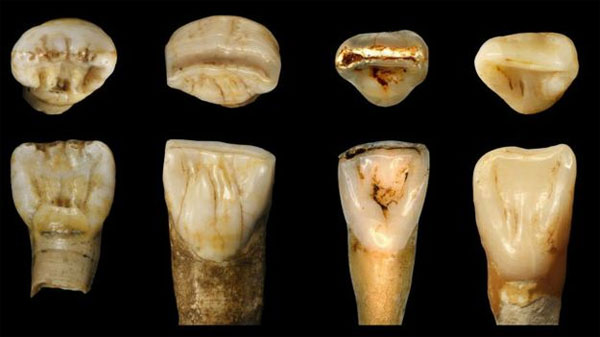The question of the human race is unknown in China
Newly tested fossils indicate that a new, never-before-known strain of humans may have lived in northern China about 60,000 to 120,000 years ago.
The trace was found in a cave in the Xujiayao area of China in 1976, including a number of skull bones and nine teeth belonging to four people. María Martinón-Torres and her colleagues from Spain's Center for Human Evolution Research analyzed their characteristics and compared them to 5,000 representative tooth samples for people known to humans.

Left teeth are found in caves in Xujiayao.The right teeth belong to modern people.(Photo: BBC)
These fossils are not the same as the teeth of the smart H. sapiens. They have some primitive characteristics that may resemble H. erectus or Neanderthal. Some of the other bones found at the same site are not the same as any primitive person ever known.
However, Martinón-Torres is reluctant to claim that they belong to a new race."What we see belongs to a new group of people. It is not H. sapiens nor H. neanderthalensis. They are a mixture of something original that we do not know. But we It is impossible to say that this is a new strain because it still needs research and comparison with many other factors, " Martinón-Torres said.
In fact, they may be similar to the strain that once existed, even as the Denisovans. The Denisovans used to live in our time, but there was little information about them. The only fossil was found in a cave in Siberia, consisting of two teeth and a small finger bone. DNA analysis shows that they are far different from modern Neanderthals and humans, but have both characteristics. Xuji's teeth are similar.

About 195,000 years ago, Homo sapiens, also known as smart people, began to appear in Africa.Homo sapiens are considered to have the closest relationship with modern people today.(Photo: Telegraph)
This opinion does not receive the full consent of experts. Darren Curnoe, a researcher at New South Wales State University, Australia, identified specimens that could prove the presence of an unrecognized human race.
Meanwhile, others agreed with the cautiousness of Martinón-Torres. According to expert Matthew Skinner of Kent University, England, fossils in Asia are quite small, so it is difficult to determine.
Other opinions suggest that Homo may be a variant of a human race. Therefore, finding a different tooth model is not surprising. It is hypothesized that there is more than one human race in Asia, even the ancestors of modern Europeans. However, most of us think that Africa is the cradle of humanity, so this idea is controversial.
- Maintain a race without mating
- Why did human ancestors win the evolution race?
- The corpse of an unknown man on the beach: Australia's oldest mystery
- China will lead India in the 2008 energy race
- The first race on the Moon may take place next year
- Hot universe race in Asia
- US - China 'arms race' on the internet
- Shenzhou 10 and the space race
- Be careful with the technology of processing dirty ducklings
- Easy to 'race' up space
- Race sperm
- Race determines the speed of aging?
 Discovered an ancient centipede fossil 99 million years old
Discovered an ancient centipede fossil 99 million years old Discovered bat-like dinosaurs in China
Discovered bat-like dinosaurs in China Discovered a 200-year-old bronze cannon of the coast
Discovered a 200-year-old bronze cannon of the coast Discover 305 million-year-old spider fossils
Discover 305 million-year-old spider fossils